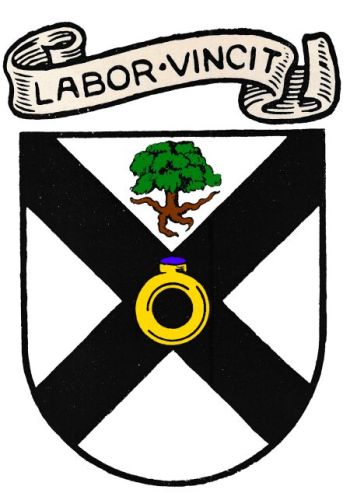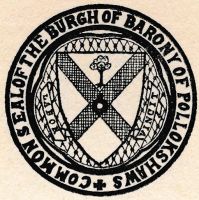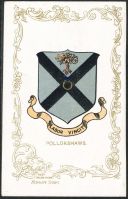Pollokshaws: Difference between revisions
Knorrepoes (talk | contribs) (Created page with "{{uk}} '''POLLOCKSHAWS''' Incorporated into : 1912 Glasgow center|350 px|Arms (crest) of Pollokshaws ===Official blazon=== Argent, on a saltir...") |
Knorrepoes (talk | contribs) m (Text replacement - "Literature : " to "'''Literature''': ") |
||
| (2 intermediate revisions by the same user not shown) | |||
| Line 18: | Line 18: | ||
in 1858, and, under the Burgh Police Act of 1892, adopted a Common Seal. | in 1858, and, under the Burgh Police Act of 1892, adopted a Common Seal. | ||
The seal is an adaptation from the Pollok Coat of Arms, by permission from Sir John Stirling Maxwell, the then representative of the Pollok Family. It is one of the quarters of the Pollok Arms: "Argent, on a saltire sable an annulet or, stoned proper." The annulet or ring was a maternal difference added to the | The seal is an adaptation from the Pollok Coat of Arms, by permission from Sir John Stirling Maxwell, the then representative of the Pollok Family. It is one of the quarters of the Pollok Arms: "Argent, on a saltire sable an annulet or, stoned proper." The annulet or ring was a maternal difference added to the arms of the Maxwells of Pollok from the House of Eglinton; and the saltire sable is from the arms of the Maxwells, Earls of Nithsdale. See also [[Pollokshields]]. | ||
An addition was made in the seal by introducing a tree between the upper arms of the saltire, which tree alludes to the latter part of the name, "shaws" (from an old Scottish word " shaw " or " schaw " [schagh], meaning a wood or a grove), as indicating that the surrounding country was of a thickly wooded character in times long past. | An addition was made in the seal by introducing a tree between the upper arms of the saltire, which tree alludes to the latter part of the name, "shaws" (from an old Scottish word " shaw " or " schaw " [schagh], meaning a wood or a grove), as indicating that the surrounding country was of a thickly wooded character in times long past. | ||
===Image gallery=== | |||
<gallery widths=250px heights=200px perrow=0> | <gallery widths=250px heights=200px perrow=0> | ||
File:Pollokshawsseal.jpg|alt=Arms (crest) of Pollokshaws|Seal of the burgh as used in the 1890s | File:Pollokshawsseal.jpg|alt=Arms (crest) of Pollokshaws|Seal of the burgh as used in the 1890s | ||
| Line 29: | Line 30: | ||
{{media}} | {{media}} | ||
[[Literature]] : Porteous, 1906; Bute et al, 1903; Fox-Davies, 1915 | [[Civic Heraldry Literature - United Kingdom|'''Literature''']]: | ||
Porteous, 1906; Bute et al, 1903; Fox-Davies, 1915 | |||
[[Category:United Kingdom Municipalities P]] | [[Category:United Kingdom Municipalities P]] | ||
[[Category:Scotland]] | [[Category:Scotland]] | ||
Latest revision as of 13:54, 7 January 2024
| Heraldry of the World |
| British heraldry portal Civic heraldry of the United Kingdom |
|
POLLOCKSHAWS
Incorporated into : 1912 Glasgow
Official blazon
Argent, on a saltire sable an annulet or, stoned azure; in chief an oak-tree eradicated proper.
Motto: Labor Vincit
Origin/meaning
The arms were never officially registered.
Pollokshaws was erected into a Burgh of Barony about 1813, and the charter was granted in favour of the then Sir John Maxwell of Pollok, hence the first part of the name. It came under the various previous Police Acts in 1858, and, under the Burgh Police Act of 1892, adopted a Common Seal.
The seal is an adaptation from the Pollok Coat of Arms, by permission from Sir John Stirling Maxwell, the then representative of the Pollok Family. It is one of the quarters of the Pollok Arms: "Argent, on a saltire sable an annulet or, stoned proper." The annulet or ring was a maternal difference added to the arms of the Maxwells of Pollok from the House of Eglinton; and the saltire sable is from the arms of the Maxwells, Earls of Nithsdale. See also Pollokshields.
An addition was made in the seal by introducing a tree between the upper arms of the saltire, which tree alludes to the latter part of the name, "shaws" (from an old Scottish word " shaw " or " schaw " [schagh], meaning a wood or a grove), as indicating that the surrounding country was of a thickly wooded character in times long past.
Image gallery
The arms on a JaJa card
Contact and Support
Partners:
Your logo here ?
Contact us
© since 1995, Heraldry of the World, Ralf Hartemink 
Index of the site
Literature: Porteous, 1906; Bute et al, 1903; Fox-Davies, 1915














